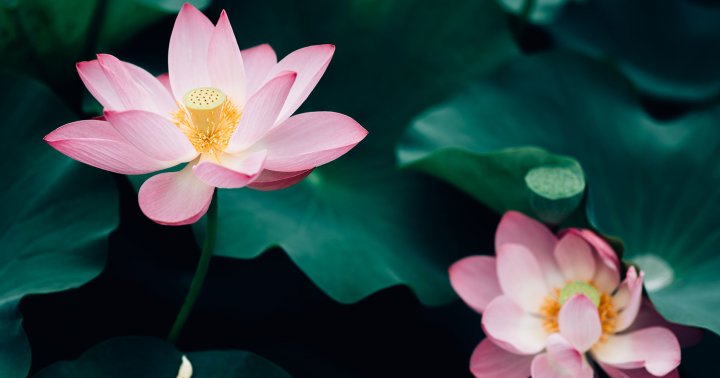This Spiritual Symbol Is A Magnet For Good Luck: Here's How To Use It
The lotus is revered for its resilience and, of course, its beauty.

For centuries, the lotus flower has been depicted in different religions and countries around the world. Miraculously growing in the murkiest of conditions, the lotus is a lucky symbol that's revered for its resilience, and of course, its beauty.
Here, we take a closer look at the history and significance of this flower, plus how you can work with its symbolism in your own life.
History of the lotus flower.
Lotus flowers have a long, rich history spanning thousands of years. Naturally occurring in many countries in Southeast Asia and Australia, they're also found in ancient Egyptian hieroglyphics, as well as folklore in ancient Greece.
As an assistant professor of religious studies at Florida International University Steven Vose, Ph.D., tells mbg, "The lotus flower appears on some of the earliest Buddhist and Jain imagery we have in South Asia," going as far back as the time of Emperor Ashoka around 250 BCE.
Vose adds that lotuses were also used in Buddhist stupas (spherical shrines) as early as 180 BCE, "as a source and support for a goddess who is eventually known as Lakshmi."
Because the lotus was also popular among the Indo-Greeks (an ancient nomadic people of Eurasia), Vose says it's "unclear geographically where the image first arose," but by the first few centuries of the Common Era, "it is well established to see the Buddha, Jinas, and Hindu gods and goddesses emerging from lotus flowers."
Today, the lotus is the national flower of both India and Vietnam.
What it means in spirituality and religion.
The lotus has its place in a number of religions, particularly in the East. According to Dheepa Sundaram, Ph.D., assistant professor of religious studies at the University of Denver, lotus flowers in Hinduism represent the womb of the universe from which all things are born, as well as overcoming adversity.
"Lotuses only grow in really swampy areas, so that symbolizes this idea that out of ugliness and destruction and unrest, we can all come together in this perfect moment," she previously explained to mbg.
The lotus flower also represents connection, she added, "and in that respect, it also has an indirect relation to the Buddhist idea of the universal soul."
Emerging from murky water with clean petals, Vose adds that the lotus is thought of as a symbol of purity and transcendence, as well as spiritual purification and liberation (aka Nirvana). "Beyond this, the lotus is also a symbol of the singular source of creation," he adds.
Feng shui expert Anjie Cho expands on this idea, noting that the lotus can also be thought of as an embodiment of a mandala, with a center point that expands outward. Within that center, we find the singular source Vose speaks of.
And in Hinduism, Cho adds, there is a popular mantra that describes the lotus as a symbol for enlightenment: Om mani padme hum, which translates from Sanskrit to (roughly), Praise the jewel in the lotus.
"All the wisdom is within us, so the 'jewel,' the 'treasure,' is in us—and we are the lotus flower," Cho explains.
Different types of lotus flowers and their meaning:
How to use this symbol respectfully.
Want to work the lotus's themes of purity, beauty, and transcendence into your life? Here are a few ways to do so that are respectful of the symbol's rich history:
First, Cho suggests brushing off your art supplies and drawing some lotus flowers of your own. "You can draw three different types of lotuses," she adds, from the lotus bud that represents potential and new birth to a lotus mid-bloom, or a lotus in full bloom, "like a person in full bloom."
Like drawing a mandala, this mindful activity can have a relaxing, meditative quality.
According to Vose, "People in South Asia frequently keep images—photos, paintings, drawings, etc.—of lotuses in their homes." Many images of the gods, Buddhas, and Jinas also often show them sitting or standing on lotuses, he adds.
Cho says anyone can bring lotus imagery into their home and let it serve as a reminder that "we have all the potential to rise above all challenges and bring forth something beautiful and pure."
Lotus pose, or "padmasana" in Sanskrit, is a deep hip-opening stretch that involves sitting cross-legged with both feet resting on top of the opposite thigh. (Here's our full primer on how it's done.)
It's a great flower-inspired pose for balancing the root chakra, as it allows the base of the spine to root into the earth and is a popular way to sit for meditation.
Last but not least, you can also bring real lotuses into your surroundings, Cho says, whether it's inside your home or in an outdoor garden, given you live in the right climate.
There's something we can all learn from a flawless flower that grows unscathed despite its surroundings—a metaphor that's inspired people for centuries. However you decide to work with the lotus, may it bring more beauty into your life.

 Troov
Troov 
































